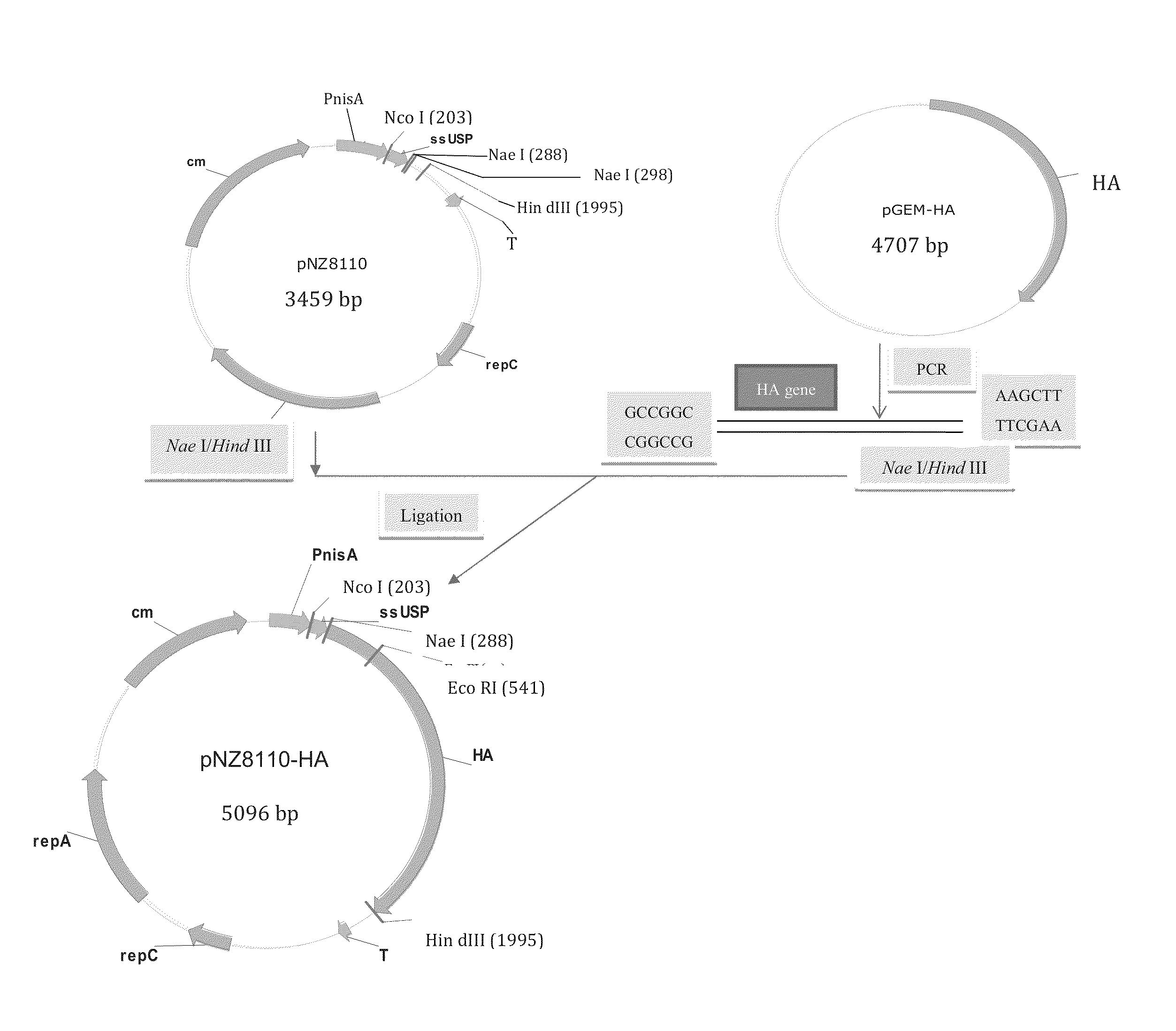Oral vaccines produced and administered using edible micro-organisms including lactic acid bacterial strains
a technology of edible microorganisms and oral vaccines, which is applied in the direction of antibody medical ingredients, dsdna viruses, immunological disorders, etc., can solve the problems of increasing the difficulty of effective control of bacterial pathogens by antibiotics, food shortages, human health problems, etc., and achieve strong ha-specific humoral and mucosal immune responses and greatly improved results
- Summary
- Abstract
- Description
- Claims
- Application Information
AI Technical Summary
Benefits of technology
Problems solved by technology
Method used
Image
Examples
example 1
Creation of Plasmid Constructs
[0347]In the present invention, various recombinant L. lactis vectors encoding the hemagglutinin (HA) gene of avian influenza virus H5N1 was constructed. Certain live vectors were encapsulated inside alginate microcapsules or enteric coating capsules to protect them from acid destruction and maintain antigen expression for an extended time period. Mice that were immunized orally mounted an effective immune response against H5N1 virus.
Creation of Plasmid Constructs
[0348]A 1704 bp fragment containing the HA gene from pGEM-HA (kindly originally supplied by Prof. Ze Chen, Wuhan, China) was amplified by polymerase chain reaction (PCR) using the following primer pairs with NaeI or HindIII sites underlined (5′-tctgccggcgagaaaatagtgcttctt-3′ (SEQ ID NO: 53), 5′-cccaagctttaaatgcaaattctgcattgtaacg-3′ (SEQ ID NO: 54). The PCR product was sequenced. The resulting NaeI / HindIII fragment was cloned into various plasmids which were transformed into L. lactis bacterial ...
example 2
Materials and Methods
[0358]The following experiments in Example 2 concern pNZ8110-HA, L. lactis-pNZ8110-HA (and clone Llactis-NZ9700(HA)) alone.
Transformation
[0359]L. lactis NZ9700 was purchased from NIZO (Netherlands) and cultured in M17 broth medium (Difco, Sparks, Md., USA) containing 0.5% (WN) glucose (GM17) at 30° C. overnight without agitation. The L. lactis NZ9700 transfected with the pNZ8110-HA plasmid by electroporation using a Gene Pulser (Bio-Rad) at 25 uF, 1000V with 0.1-cm electrode cuvette (Bio-Rad).
[0360]The highest HA expressing clone was selected and named Llactis-NZ9700(HA) (plasmid shown in FIG. 5). As a negative control, L. lactis NZ9700 was transformed with empty vector pNZ8110 (NIZO, Netherlands) to generate L. lactis-pNZ8110.
[0361]An analysis of the rate of growth of the cultures of L. lactis-pNZ9700(HA), L. lactis-p-NZ8110 and L. lactis NZ9700 (wild type) (FIG. 6).
[0362]Plasmid DNA was isolated from L. lactis NZ9700 for PCR detection and sequencing of the tar...
example 3
Materials and Methods
[0381]The following experiments in Example 3 concern challenge experiments involving a comparison of clone L. lactis-pNZ9700(HA) vis-à-vis control bacteria L. lactis-pNZ8110, as well as L. lactis-pNZ8110-HA vis-à-vis a wild type control.
Protection Against Lethal H5N1 Virus Challenge
[0382]Eight-week-old female BALB / c mice were used in all experiments. Influenza A virus (A / chicken / Henan / 12 / 2004(H5N1)) was used for the virus challenge. Fifty percent mouse infectious dose (MID50) and 50% lethal dose (LD50) titers were determined. To test whether L. lactis-pNZ8110-HA inoculated mice could stand against a H5N1 virus challenge, lethal challenge experiments were performed at the tenth week after five biweekly oral dosings. To evaluate the degree of protection from lethal challenges, vaccinated mice were infected intranasally (i.n.) with 10 LD50 of Influenza A virus (A / chicken / Henan / 12 / 2004(H5N1)) virus (lethal challenge dose). Six mice from each group were examined dail...
PUM
 Login to View More
Login to View More Abstract
Description
Claims
Application Information
 Login to View More
Login to View More - R&D
- Intellectual Property
- Life Sciences
- Materials
- Tech Scout
- Unparalleled Data Quality
- Higher Quality Content
- 60% Fewer Hallucinations
Browse by: Latest US Patents, China's latest patents, Technical Efficacy Thesaurus, Application Domain, Technology Topic, Popular Technical Reports.
© 2025 PatSnap. All rights reserved.Legal|Privacy policy|Modern Slavery Act Transparency Statement|Sitemap|About US| Contact US: help@patsnap.com



